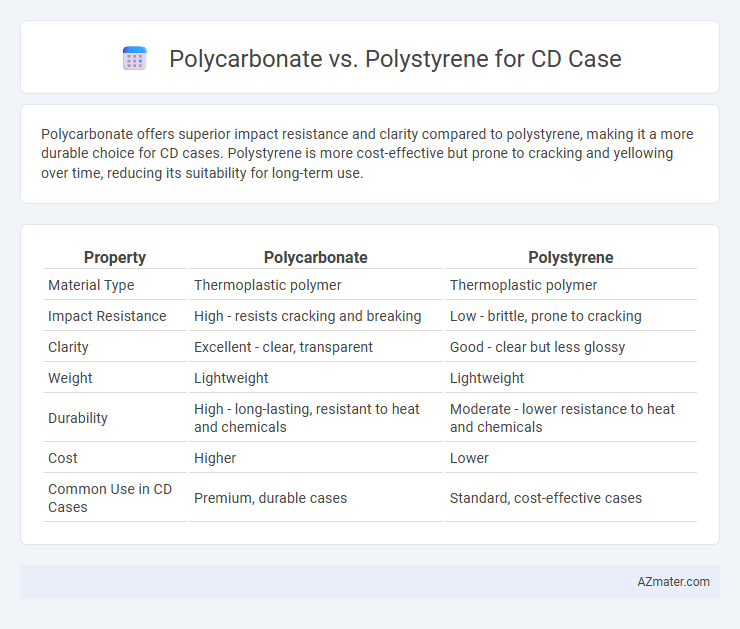Polycarbonate offers superior impact resistance and clarity compared to polystyrene, making it a more durable choice for CD cases. Polystyrene is more cost-effective but prone to cracking and yellowing over time, reducing its suitability for long-term use.
Table of Comparison
| Property | Polycarbonate | Polystyrene |
|---|---|---|
| Material Type | Thermoplastic polymer | Thermoplastic polymer |
| Impact Resistance | High - resists cracking and breaking | Low - brittle, prone to cracking |
| Clarity | Excellent - clear, transparent | Good - clear but less glossy |
| Weight | Lightweight | Lightweight |
| Durability | High - long-lasting, resistant to heat and chemicals | Moderate - lower resistance to heat and chemicals |
| Cost | Higher | Lower |
| Common Use in CD Cases | Premium, durable cases | Standard, cost-effective cases |
Introduction to CD Case Materials
Polycarbonate and polystyrene are the primary materials used for CD cases, each offering distinct properties that impact durability and clarity. Polycarbonate provides superior impact resistance and optical clarity, making it ideal for reusable and long-lasting standard jewel cases. Polystyrene, while more cost-effective and easier to mold, tends to be more brittle and less resistant to cracking, often used in disposable or budget CD packaging.
Overview of Polycarbonate
Polycarbonate is a durable, impact-resistant thermoplastic widely used for CD cases due to its high transparency and excellent optical clarity, which protects discs from scratches and UV damage. Its superior mechanical strength and heat resistance make it a preferred choice over polystyrene, which is more brittle and prone to cracking. Polycarbonate also offers better longevity and environmental resistance, ensuring the safe storage and preservation of CDs over time.
Overview of Polystyrene
Polystyrene is a lightweight, clear plastic commonly used for CD cases due to its low cost and ease of manufacturing. It offers good rigidity and transparency but is more brittle and prone to cracking compared to polycarbonate. Polystyrene's lower impact resistance and susceptibility to scratches make it less durable under frequent handling.
Mechanical Strength Comparison
Polycarbonate offers superior mechanical strength compared to polystyrene, making it highly resistant to impact and less prone to cracking or breaking under stress in CD cases. Polystyrene, while cost-effective, tends to be more brittle and can shatter easily upon impact, reducing the durability of CD packaging. The higher tensile strength and toughness of polycarbonate ensure longer-lasting protection for CDs during handling and transportation.
Optical Clarity and Appearance
Polycarbonate offers superior optical clarity with higher light transmittance and less yellowing compared to polystyrene, making it ideal for CD cases requiring clear visibility and long-lasting transparency. Polystyrene tends to have a lower gloss and is more prone to surface scratches and discoloration over time, affecting the overall appearance. The durability and clarity of polycarbonate enhance the aesthetic value and protective function of CD cases.
Durability and Impact Resistance
Polycarbonate CD cases offer superior durability and impact resistance compared to polystyrene, making them less prone to cracking or breaking under stress. Polycarbonate's high tensile strength and ability to absorb shocks protect discs more effectively during drops or rough handling. Polystyrene cases, while more cost-effective, tend to be brittle and can easily shatter, reducing their lifespan and protective capability.
Cost and Manufacturing Considerations
Polycarbonate offers higher durability and impact resistance for CD cases but comes with increased raw material costs and more complex injection molding processes compared to polystyrene. Polystyrene is favored for its lower cost and ease of manufacturing, enabling faster production cycles, yet it exhibits lower impact strength and is more prone to cracking. Choosing between polycarbonate and polystyrene depends heavily on balancing budget constraints with desired product longevity and manufacturing efficiency.
Environmental and Recycling Factors
Polycarbonate for CD cases offers superior durability and is often recyclable through specialized programs, reducing environmental impact compared to polystyrene, which is less commonly recycled and tends to contribute more to plastic waste due to its brittleness and lower lifespan. Polystyrene, while cheaper and lighter, is typically considered a single-use plastic with limited recycling options and greater environmental concerns due to its tendency to fragment into microplastics. Choosing polycarbonate aligns better with sustainable packaging goals, as it supports longer product life and more efficient recycling infrastructures.
Common Applications in CD Packaging
Polycarbonate is favored for CD cases due to its high impact resistance and clarity, making it ideal for durable, long-lasting packaging. Polystyrene, on the other hand, is commonly used for budget-friendly CD jewel cases because of its stiffness and ease of molding, though it is more brittle compared to polycarbonate. Both materials serve distinct roles in CD packaging, with polycarbonate preferred for reusable and protective cases, while polystyrene suits disposable or low-cost packaging solutions.
Conclusion: Choosing the Right Material
Polycarbonate offers superior impact resistance and durability, making it ideal for long-lasting CD cases that protect against drops and scratches. Polystyrene is more cost-effective and lightweight but tends to be more brittle and less durable over time. Select polycarbonate for premium quality and longevity, while polystyrene suits budget-conscious projects requiring lighter, less impact-resistant cases.

Infographic: Polycarbonate vs Polystyrene for CD Case
 azmater.com
azmater.com